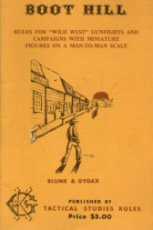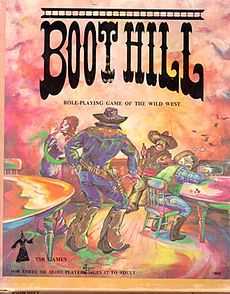Boot Hill (role-playing game)
|
Second edition 1979 cover. | |
| Designer(s) |
Brian Blume Gary Gygax |
|---|---|
| Publisher(s) | TSR, Inc. |
| Publication date | 1975 |
| Genre(s) | Western |
Boot Hill is a western-themed role-playing game designed by Brian Blume, Gary Gygax, and Don Kaye (although Kaye unexpectedly died before the game was published), and first published in 1975. Boot Hill was TSR's third role-playing game, appearing not long after Dungeons and Dragons and Empire of the Petal Throne, and taking its name from the popular Wild West term for "cemetery". Boot Hill was marketed to take advantage of America's love of the western genre. The game did feature some new game mechanics, such as the use of percentile dice, but its focus on gunfighting rather than role-playing, as well as the lethal nature of its combat system, limited its appeal. Boot Hill was issued in three editions over 15 years, but it never reached the same level of popularity as D&D and other fantasy-themed role-playing games.
Creative origins

Soon after TSR was formed by Gary Gygax and Don Kaye in late 1973, they and new business partner Brian Blume started development of the rules for a Western genre miniatures combat system and role-playing game called Boot Hill.[1] Kaye in particular was an avid supporter of Boot Hill[2]—he was a fan of the Western genre, and even his fantasy D&D character, Murlynd, was dressed and armed as a cowboy after being magically transported from Gygax's Greyhawk campaign to an alternate universe set in the Wild West.
However, Kaye unexpectedly died of a heart attack in January 1975.[1] Blume and Gygax subsequently published Boot Hill later that year in memory of their friend.[3] It was TSR's third role-playing game, after Dungeons and Dragons and Empire of the Petal Throne.[4]
System
Boot Hill used game mechanics that were advanced for the time. Most games still used traditional six-sided dice, but Boot Hill was one of the first games to use two ten-sided dice as percentile dice for character abilities and skill resolution.[5] However, several factors limited its appeal.
The western was a popular American motif, but the game did not have the same mass appeal as a D&D's Tolkienesque fantasy setting.[5]
Boot Hill focused on gunfighting rather than role-playing. The first edition and second editions were specifically marketed as a miniatures combat game, but even in the third edition, most of the rules concerned combat resolution, with relatively few social interaction rules or information about settings.[5]
In addition, combat could be short and deadly, with death often coming from the first gunshot.[5] This lethality did not change over time, since Boot Hill characters did not advance in levels and therefore developed no better defenses or any true advantage over non-player characters, unlike D&D characters; they remained just as likely to die in their hundredth combat as they had been in their first. As a result, most characters had a very short life span; this meant that players generally had no chance to identify with their player character over the long term, as they could with a player character in D&D.
Unlike D&D, there were no non-human monsters, only human opponents. In addition, there were no alignment rules, making the difference between the "good guys" and "bad guys" a matter of moral interpretation or choice.[6]
Boot Hill was published in three editions, but none captured the public imagination for these reasons, and it remained a very small and limited member of TSR's stable of games.[5]
Publications

- 1st edition, printed in 1975, 34 pages, no ISBN.
- 2nd edition, printed in 1979, ISBN 0-394-51875-6. Reprinted with a different cover in 1984.
- 3rd edition, printed in 1990, ISBN 0-88038-976-1.
Boot Hill, 2nd Edition was supported by a referee's screen and five 32 page adventure modules:
- Referee's Screen and Mini-Module, ISBN 0-394-52590-6.
- Mad Mesa (BH1), printed in 1981, ISBN 0-935696-71-7, and 1982, ISBN 0-394-52705-4. Written to be playable solitaire, as a gamebook, or as a multiplayer module.
- Lost Conquistador Mine (BH2), printed in 1982, ISBN 0-394-52594-9.
- Ballots and Bullets (BH3), 1982, ISBN 0-394-53067-5.
- Burned Bush Wells (BH4), 1984, ISBN 0-394-53466-2.
- Range War! (BH5), 1984, ISBN 0-88038-105-1.
TSR also released a three-figure pack of gunslinger miniatures for Boot Hill. Dragon Magazine issue 71 features the Boot Hill module "The Taming of Brimstone" by Donald Mumma which was the winner of a module design contest.
See also
- Boot Hill - the Wild West cemetery, original meaning of the term
References
- ↑ 1.0 1.1 "In Memorium". The Strategic Review (Lake Geneva, Wisconsin: TSR, Inc.) (#2): 1. Summer 1975.
- ↑ Kuntz: "Don was a great fan of the Western and an avid supporter of the Boot Hill rules." "Robilar Remembers: Murlynd". Pied Piper Publishing. 2004-10-18. Retrieved 2009-09-16.
- ↑ Lynch, Scott (2001-05-17). "Interview with Gary Gygax, part 2 of 3". RPGnet.
- ↑ "The History of TSR". Wizards of the Coast. Archived from the original on 2008-10-04. Retrieved 2005-08-20.
- ↑ 5.0 5.1 5.2 5.3 5.4 "Ride, Cowboy, Ride - The Forgotten Boot Hill". Gamegrene. Disobey. 2000-12-29. Retrieved 2012-10-26.
- ↑ Beddow, Dominic (Dec 1979 – Jan 1980). "Open Box". White Dwarf (review) (Games Workshop) (16): 23–24.
- Pope, Thomas. The Stuff of Legends - TSR: Boot Hill
External links
- Boot Hill - TSR's Wild West RPG Krakow RPGs has a complete bibliography with cover photos.
- Boot Hill, 2nd Edition - Review from the Museum of Roleplaying Games.
- Ride, Cowboy, Ride - The Forgotten Boot Hill - Review from GameGrene
- Boot Hill - Demian's Gamebook Web Page, mostly on the solitaire module, Mad Mesa.
